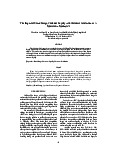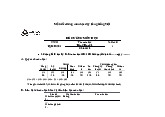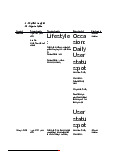








Preview text:
11:08, 16/06/2022
CCNA Training » DNA Center Questions Type text to search here... Home > DNA Center Questions DNA Center Questions
January 8th, 2021 Go to comments DNA Center Quick Summary
Software-Defined Access (SDA) uses the software-defined architectural model, with a controller and various
APIs. At the center sits the Digital Network Architecture (DNA) Center controller.
DNA Center is the controller for SDA networks. The southbound side of the controller contains the fabric, underlay, and overlay:
Overlay: The mechanisms to create VXLAN tunnels between SDA switches, which are then used to transport
traffic from one fabric endpoint to another over the fabric.
Underlay: The network of devices and connections (cables and wireless) to provide IP connectivity to all nodes
in the fabric, with a goal to support the dynamic discovery of all SDA devices and endpoints as a part of the
process to create overlay VXLAN tunnels.
https://www.9tut.com/dna-center-questions 1/9 11:08, 16/06/2022
CCNA Training » DNA Center Questions
The relationship between Overlay and Underlay is shown below:
Fabric: The combination of overlay and underlay, which together provide all features to deliver data across the
network with the desired features and attributes
Reference: CCNA 200-301 Official Cert Guide
Cisco DNA Center is a software solution that resides on the Cisco DNA Center appliance. The solution receives
data in the form of streaming telemetry from every device (switch, router, access point, and wireless access
controller) on the network. This data provides Cisco DNA Center with the real-time information it needs for the many functions it performs.
Cisco DNA Center collects data from several different sources and protocols on the local network, including the
following: traceroute; syslog; NetFlow; Authentication, Authorization, and Accounting (AAA); routers;
Dynamic Host Configuration Protocol (DHCP); Telnet; wireless devices; Command-Line Interface (CLI);
Object IDs (OIDs); IP SLA; DNS; ping; Simple Network Management Protocol (SNMP); IP Address
Management (IPAM); MIB; Cisco Connected Mobile Experiences (CMX); and AppDynamics.
Cisco DNA Center offers 360-degree extensibility through four distinct types of platform capabilities:
+ Intent-based APIs leverage the controller and enable business and IT applications to deliver intent to the
network and to reap network analytics and insights for IT and business innovation. The Intent API provides
policy-based abstraction of business intent, allowing focus on an outcome rather than struggling with individual mechanisms steps.
For example, the administrator configures the intent or outcome desired of a set of security polices. The DNA
Center then communicates with the devices to determine exactly the required configuration to achieve that
intent. Then the complete configuration is sent down to the devices.
https://www.9tut.com/dna-center-questions 2/9 11:08, 16/06/2022
CCNA Training » DNA Center Questions
+ Process adapters, built on integration APIs, allow integration with other IT and network systems to
streamline IT operations and processes.
+ Domain adapters, built on integration APIs, allow integration with other infrastructure domains such as data
center, WAN, and security to deliver a consistent intent-based infrastructure across the entire IT environment. +
allow management to be extended to third-party vendor SDKs
’s network devices to offer support for diverse environments.
Premium Member: You can test your knowledge with these questions first via this link (via HTML). Question 1
Which two capacities of Cisco DNA Center make it more extensible? (Choose two)
A. adapters that support all families of Cisco IOS software
B. SDKs that support interaction with third-party network equipment
C. customized versions for small, medium, and large enterprises
D. REST APIs that allow for external applications to interact natively with Cisco DNA Center
E. modular design that is upgradable as needed Answer: B D Explanation
Cisco DNA Center offers 360-degree extensibility through four distinct types of platform capabilities:
+ Intent-based APIs leverage the controller and enable business and IT applications to deliver intent to the
network and to reap network analytics and insights for IT and business innovation.
+ Process adapters, built on integration APIs, allow integration with other IT and network systems to
streamline IT operations and processes.
+ Domain adapters, built on integration APIs, allow integration with other infrastructure domains such as data
center, WAN, and security to deliver a consistent intent-based infrastructure across the entire IT environment. +
allow management to be extended to third-party vendor SDKs
’s network devices to offer support for diverse environments.
Reference: https://www.cisco.com/c/en/us/products/collateral/cloud-systems-management/dna-center/nb-06-dna- cent-platf-aag-cte-en.html Question 2
What makes Cisco DNA Center different from traditional network management applications and their management of networks?
A. It only supports auto-discovery of network elements in a green field deployment.
B. It modular design allows someone to implement different versions to meet the specific needs of an organization
C. It abstracts policy from the actual device configuration
D. It does not support high availability of management functions when operating in cluster mode Answer: C Question 3
https://www.9tut.com/dna-center-questions 3/9 11:08, 16/06/2022
CCNA Training » DNA Center Questions
How does Cisco DNA Center gather data from the network?
A. Network devices use different services like SNMP, syslog, and streaming telemetry to send data to the controller
B. Devices establish an iPsec tunnel to exchange data with the controller
C. Devices use the call-home protocol to periodically send data to the controller
D. The Cisco CU Analyzer tool gathers data from each licensed network device and streams it to the controller Answer: A Explanation
Cisco DNA Center is a software solution that resides on the Cisco DNA Center appliance. The solution receives
data in the form of streaming telemetry from every device (switch, router, access point, and wireless access
controller) on the network. This data provides Cisco DNA Center with the real-time information it needs for the many functions it performs.
Reference: https://www.cisco.com/c/en/us/products/collateral/cloud-systems-management/dna-center/nb-06-dna- center-data-sheet-cte-en.html
Cisco DNA Center collects data from several different sources and protocols on the local network, including the
following: traceroute; syslog; NetFlow; Authentication, Authorization, and Accounting (AAA); routers;
Dynamic Host Configuration Protocol (DHCP); Telnet; wireless devices; Command-Line Interface (CLI);
Object IDs (OIDs); IP SLA; DNS; ping; Simple Network Management Protocol (SNMP); IP Address
Management (IPAM); MIB; Cisco Connected Mobile Experiences (CMX); and AppDynamics.
Reference: https://www.cisco.com/c/en/us/products/collateral/cloud-systems-management/dna-center/nb-06-dna- center-faq-cte-en.html Question 4
How do traditional campus device management and Cisco DNA Center device management differ in regards to deployment?
A. Cisco DNA Center device management can deploy a network more quickly than traditional campus device management
B. Traditional campus device management allows a network to scale more quickly than with Cisco DNA Center device management
C. Cisco DNA Center device management can be implemented at a lower cost than most traditional campus device management options
D. Traditional campus device management schemes can typically deploy patches and updates more quickly than
Cisco DNA Center device management Answer: A Explanation
With Intent-based APIs, the administrator configures the intent or outcome desired of a set of security polices.
The DNA Center then communicates with the devices to determine exactly the required configuration to achieve
that intent. Then the complete configuration is sent down to the devices -> This helps reduce time to deploy a
network compare to the traditional networks.
https://www.9tut.com/dna-center-questions 4/9 11:08, 16/06/2022
CCNA Training » DNA Center Questions Question 5
What is an advantage of Cisco DNA Center versus traditional campus device management?
A. It supports numerous extensibility options including cross-domain adapters and third-party SDKs
B. It supports high availability for management functions when operating in cluster mode
C. It enables easy autodiscovery of network elements m a brownfield deployment
D. It is designed primarily to provide network assurance Answer: A Comments (9) Comments 1. tutut May 4th, 2020 1 and 2 are repeated 2. jhozy July 11th, 2020 Hi @9tut, Question 3
What makes Cisco DNA Center different from traditional network management applications and their management of networks? Answer: c answer C is correct?
answer B :It modular design allows someone to implement different versions to meet the specific needs of
an organization why couldn’t it be the correct answer? 3. wasthereonce July 20th, 2020
Which two capacities of Cisco DNA Center make it more extensible? (Choose two)
A. adapters that support all families of Cisco IOS software
B. SDKs that support interaction with third-party network equipment
C. customized versions for small, medium, and large enterprises
D. REST APIs that allow for external applications to interact natively with Cisco DNA Center E. modular
design that is upgradable as needed BD 4. EdvanPonciano January 5th, 2021 Hi @9tut
Q3. I would say option”B” is kind of more correct? 5. Shiva July 28th, 2021 @9tut
https://www.9tut.com/dna-center-questions 5/9 11:08, 16/06/2022
CCNA Training » DNA Center Questions I think Q4 C is correct. Please check the question. 6. 9tut July 29th, 2021
@Shiva: DNA Center is not a cheap solution so it cannot be implemented at a lower cost than most
traditional campus device management options. 7. Shiva July 29th, 2021 @9tut Thanks for your explanation. 8. miki November 23rd, 2021
DNA center topic in CCNA cert is more like cisco promotion than a real need for CCNA level knowledge 9. Bogatsu January 18th, 2022 Hi @9tut,
Does this questions change after February of each year or if there’s any new questions you guys will add them here? Add a Comment Name
Tôi không phải là người máy reCAPTCHA Bảo mật - Điều khoản Submit Comment Subscribe to comments feed
SDN Questions Drag Drop Questions Premium Member Zone Welcome Hai Minh! Welcome Premium Member CCNA – New Questions Part 5
https://www.9tut.com/dna-center-questions 6/9 11:08, 16/06/2022
CCNA Training » DNA Center Questions CCNA – New Questions Part 6 CCNA – New Questions Part 7 CCNA – New Questions Part 8 CCNA – New Questions Part 9 CCNA – New Questions Part 10 Composite Quizzes IP Services Sim
Static Routing Configuration Sim
Static Routing Configuration Sim 2 OSPF Configuration Sim Logout CCNA 200-301 Basic Questions
Topology Architecture Questions
Cloud & Virtualization Questions CDP & LLDP Questions Switch Questions VLAN & Trunking Questions
VLAN & Trunking Questions 2 STP & VTP Questions EtherChannel Questions TCP & UDP Questions
IP Address & Subnetting Questions IP Routing Questions IP Routing Questions 2 OSPF Questions OSPF Questions 2 EIGRP Questions NAT Questions NTP Questions Syslog Questions HSRP Questions Access-list Questions AAA Questions Security Questions Security Questions 2 DAI Questions IPv6 Questions DNS Questions QoS Questions Port Security Questions Wireless Questions Wireless Questions 2 SDN Questions DNA Center Questions Drag Drop Questions Drag Drop Questions 2 Drag Drop Questions 3 VPN Questions DHCP Questions
https://www.9tut.com/dna-center-questions 7/9 11:08, 16/06/2022
CCNA Training » DNA Center Questions Automation Questions Miscellaneous Questions CCNA FAQs & Tips Share your new CCNA Experience CCNA Self-Study Practice CCNA GNS3 Labs CCNA Knowledge CCNA Lab Challenges Puppet Tutorial Chef Tutorial Ansible Tutorial JSON Tutorial
Layer 2 Threats and Security Features
AAA TACACS+ and RADIUS Tutorial
STP Root Port Election Tutorial GRE Tunnel Tutorial Basic MPLS Tutorial TCP and UDP Tutorial
Border Gateway Protocol BGP Tutorial
Point to Point Protocol (PPP) Tutorial WAN Tutorial DHCP Tutorial
Simple Network Management Protocol SNMP Tutorial Syslog Tutorial
Gateway Load Balancing Protocol GLBP Tutorial EtherChannel Tutorial
Hot Standby Router Protocol HSRP Tutorial InterVLAN Routing Tutorial
Cisco Command Line Interface CLI
Cisco Router Boot Sequence Tutorial OSI Model Tutorial
Subnetting Tutorial – Subnetting Made Easy Frame Relay Tutorial Wireless Tutorial
Virtual Local Area Network VLAN Tutorial
VLAN Trunking Protocol VTP Tutorial IPv6 Tutorial
Rapid Spanning Tree Protocol RSTP Tutorial
Spanning Tree Protocol STP Tutorial
Network Address Translation NAT Tutorial Access List Tutorial RIP Tutorial EIGRP Tutorial OSPF Tutorial Network Resources Free Router Simulators CCNA Website
https://www.9tut.com/dna-center-questions 8/9 11:08, 16/06/2022
CCNA Training » DNA Center Questions ENCOR Website ENSDWI Website ENARSI Website DevNet Website CCIE R&S Website Security Website Wireless Website Design Website Data Center Website Service Provider Website Collaboration Website Top
Copyright © 2021 CCNA Training
Site Privacy Policy. Valid XHTML 1.1 and CSS 3.H
https://www.9tut.com/dna-center-questions 9/9




